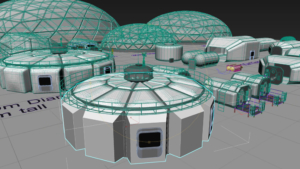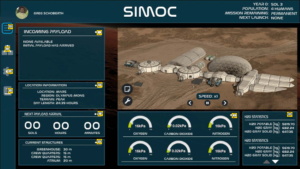


June – November 2018
Where Phase I user configuration focused on location as a means to differentiate ISRU and as such, vary the outcomes of a model run given a fixed baseline habitat design, Phase II provides the user with control over the physico-chemical ECLSS and bioregenerative systems design. A tour of Biosphere 2, attendance of the International Conference on Environmental Systems (ICES), and a deeper literature review determined that habitat design alone provides ample complexity for an engaged learning environment. Further discussion with experts at NASA and Paragon confirmed that the most critical issues in long-term, isolated human habitation are life support systems. As such, Phase I location, ISRU, and user managed habitat expansion were placed on-hold until later phases of SIMOC development.
Following the request of an associate at NASA for the capability to remove humans in order to model a plant-only system, it was concluded that we could provide advanced users the capability of editing the agents themselves. This allows for the fine-tuning of agent parameters such as CO2 intake or edible biomass production such that if a new strain of wheat is used in a real-world experiment, it may be immediately introduced into SIMOC. Furthermore, the agent library can be edited to remove, modify, or add new agents from which a subset are chosen for any given SIMOC run. With the close of July 2018, the first fully functional version was demonstrated.
Early in Phase II it was determined that a ground-up redesign of the dashboard would provide a greatly improved user experience. We brought world-renowned space habitat architect Bryan Versteeg on-board to guide design of the habitat visualization environment and provide 3D models for each user-selected component.
Added functionality includes a fully customizable layout whereby the user can select the arrangement of the panels and content contained therein. The Phase II dashboard code base is designed to auto-scale across all user products, from desktops to laptops to tablets and mobile phones. In advanced of the intended Phase II deployment, the revised dashboard provides a highly flexible, scalable, and portable platform on which to build SIMOC Phases II, III, IV, and beyond.
All agent values were double-checked and revised. A more accurate physico-chemical ECLSS and bioregenerative workflow was devised. And mass was added to the agent parameter space. Finally, and of utmost importance, Phase II saw the introduction of the educational curriculum and packages for classrooms, science centers, and individual citizen scientists, as developed by curriculum development veteran Don Boonstra.
Principal Objectives of Phase II
- Deploy a robust, flexible, user configurable dashboard.
- Employ a dynamical ABM such that each agent is determined not by hard coding, but by a configuration file and subsequent, advanced user editing.
- Provide a default agent library from which users select the agents to define a given model run.
- Provide a tool suite for advanced users to remove, edit, and add agents to the library.
- Provide an educational experience for citizen scientists in the classroom, science centers, and on-line users too.
- Provide Research Scientists a tool through which they can explore the complex arena of long-term, off-world, isolated habitation.
- Engage real-world data and research such that the SIMOC base-line configurations (based upon real experiments or missions, or not) are realistic and solid in their outcomes.

